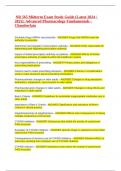ASSIGNMENT 05
NEW RELIGIOUS MOVEMENT TYPOLOGIES
This paper discusses how three different New Religious Movements fit into the typologies suggested
by Anthony and Robbins (1978) and by Wallis (), respectively. Anthony and Robbins proposed two
types of new religious movements based on its belief in a God or higher power (Dualistic) or not
(Monistic). Dualistic movements believe that God is a higher power existing in a dimension separate
from his creation and mankind. God is seen as superior and obedience to his commandments plays a
big part in such movements. Monistic movements view nature and humankind as one whole and does
not believe in a higher power.
Steyn (2009) quotes Wallis as distinguishing between three typologies, namely world-rejecting, world-
affirming and world-accommodating movements. World-rejecting movements believe that the
current world order has strayed from the true path set by the Lord. They believe that they know the
path and that all in the world that, according to them, opposes that view is wrong and should be
rejected. Such movements generally have strict moral codes, demand loyalty from their members,
live away from society and are critical of the outside world. World-affirming movements do not
believe that the world is bad or wrong as such, but that man has not reached his full potential within
this world. These movements purport to provide techniques through which people can fulfil their full
potential in this world without having to withdraw from it. The movements typically accept society,
they have mainstream values, they assist members in attaining mainstream goals and do not place
great demands on members. In world-accommodating movements, the focus is on the importance
of religion for a person’s inner life. These movements are typically breakaways from existing religions,
by members who believe that the original religion has strayed from its true path or purpose. The
breakaway movement’s focus is on religious matters, aiming to restore the perceived former purity of
the religion. These movements are not demanding and neither affirm nor reject mainstream society.
SPIRITUALISM
a) Anthony and Robbins
Spiritualism can be typified as a Dualistic movement in terms of the Anthony and Robbins
typology set. The UK Spiritualists’ National Union website (www.snu.org.uk) answers the
question: “Do Spiritualists believe in God?” as follows:
“Yes. Our first principle, “The Fatherhood of God” refers to our acknowledgement that God
is a universal presence and central to all things. Spiritualists may personally use different
names for this, such as the God Force, the Divine Spirit or the Great Spirit. However, all have
their understanding that God is the source of all life and all things.”
The fact that Spiritualists believe in God qualifies the movement as dualistic. The Declaration
of Spiritualist Principles (diversiton.com; bbc.co.uk) further has a principle affirming that the
correct understanding of the expression of Infinite Intelligence through Nature and a life lived
in accordance therewith constitutes true religion. Another principle states that individuals have
a moral responsibility and that happiness or unhappiness depend on the individual’s obedience
or disobedience to Nature’s physical and spiritual laws. This expectation of adherence to the
laws from a Higher Power is another of the criteria given by Anthony and Robbins for a
movement to be classified as Dualistic.
b) Wallis
Spiritualism resorts under the typology “world-affirming movement”. The purpose of
Spiritualism is in line with Wallis’s criteria for world-affirming movements, such as an
acceptance of society and of mainstream values, a focus on helping followers to achieve life
1






